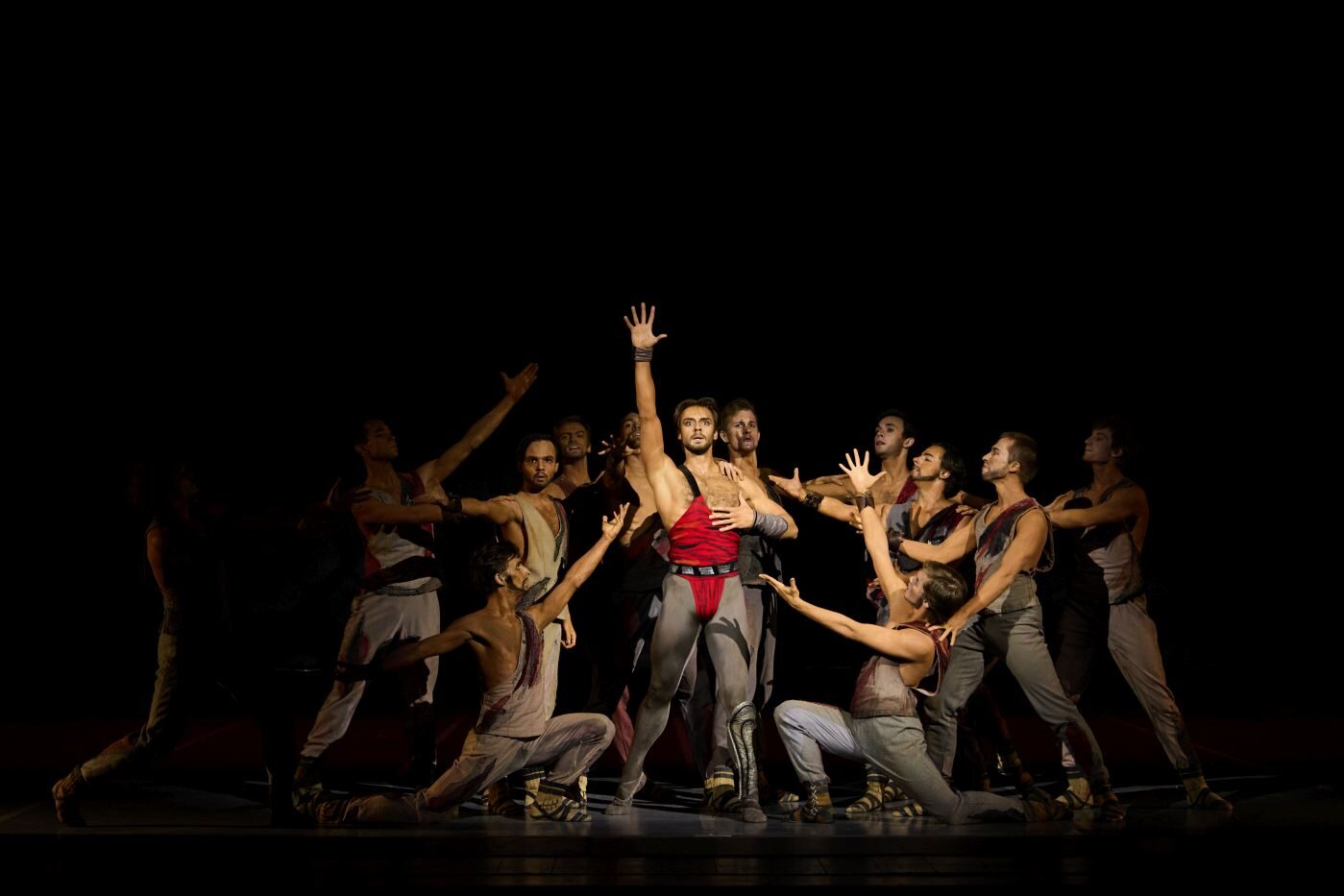“Made in Amsterdam 1”
Dutch National Ballet
Dutch National Opera & Ballet
Amsterdam, The Netherlands
February 11, 2017
by Ilona Landgraf
Copyright © 2017 by Ilona Landgraf
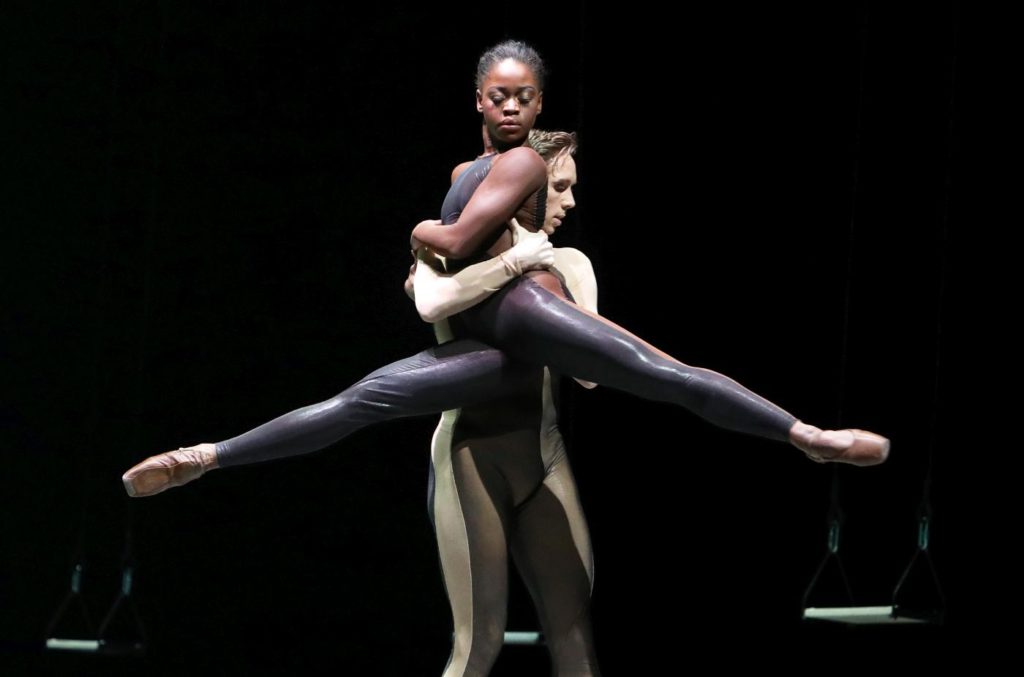 Last weekend was a busy one for Dutch National Ballet. The company premiered two mixed bills of four pieces each, one on Saturday evening, the second in a matinee on Sunday. In addition it held a two-day conference titled “Positioning Ballet” to discuss central topics concerning the art form with international guests on the panels. Clearly a huge effort had gone into its organization. It totally paid off. The weekend was a success and the conference will hopefully lead to regular meetings in the future.
Last weekend was a busy one for Dutch National Ballet. The company premiered two mixed bills of four pieces each, one on Saturday evening, the second in a matinee on Sunday. In addition it held a two-day conference titled “Positioning Ballet” to discuss central topics concerning the art form with international guests on the panels. Clearly a huge effort had gone into its organization. It totally paid off. The weekend was a success and the conference will hopefully lead to regular meetings in the future.
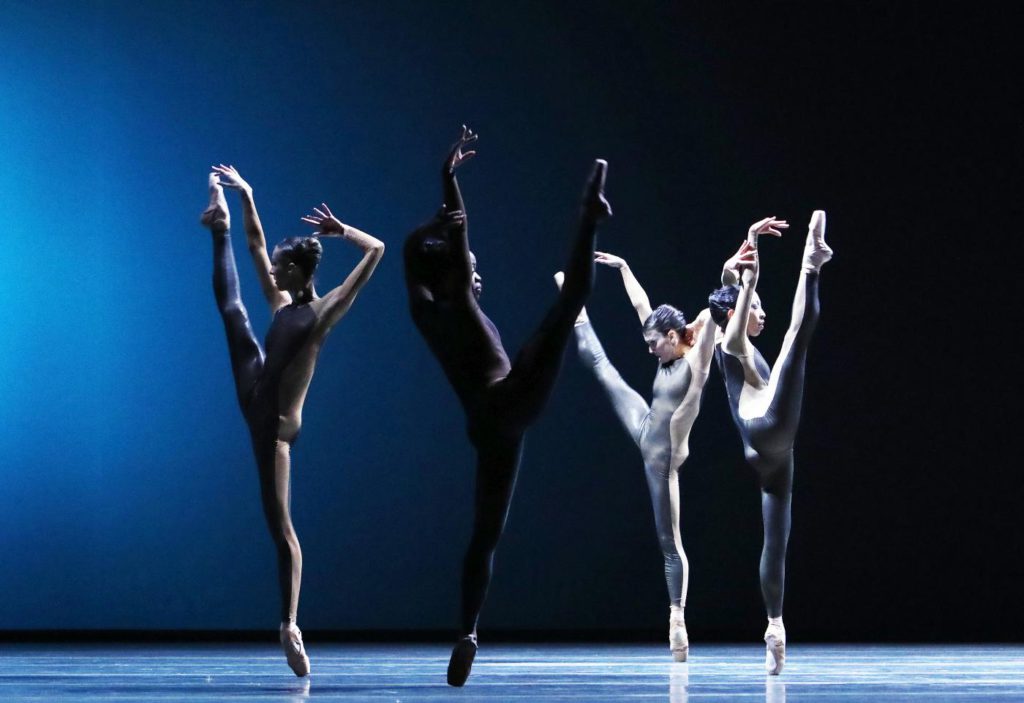 Both dance programs were dedicated to pieces created for the Dutch company. Five of the works were revivals, three world premieres. In the following below, I am reporting on the Saturday program “Made in Amsterdam 1”. “Made in Amsterdam 2” and the conference will be covered in subsequent articles.
Both dance programs were dedicated to pieces created for the Dutch company. Five of the works were revivals, three world premieres. In the following below, I am reporting on the Saturday program “Made in Amsterdam 1”. “Made in Amsterdam 2” and the conference will be covered in subsequent articles.
Saturday’s bill opened with a new piece, “Homo Ludens” (“Playing Man”) by Juanjo Arqués. Arqués hails from Murcia, Spain and formerly danced with Dutch National Ballet. But for a few years now he has solely concentrated on choreographing. This January he was appointed Young Creative Associate of the Dutch company.
The player of “Playing Man”, the one initiating and propelling the game, was neither a dancer nor a man, but rather the flautist Sarah Ouakrat. Her melody, Marc-André Dalbavie’s “Flute Concerto”, put dancer Young Gyu Choi into motion. Or is he, 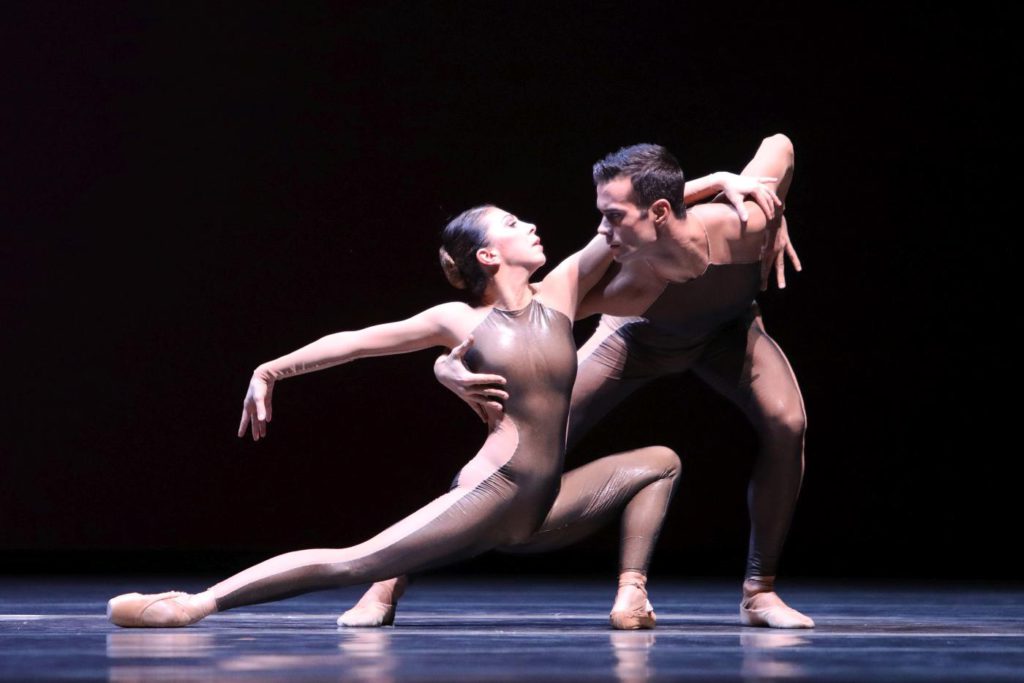
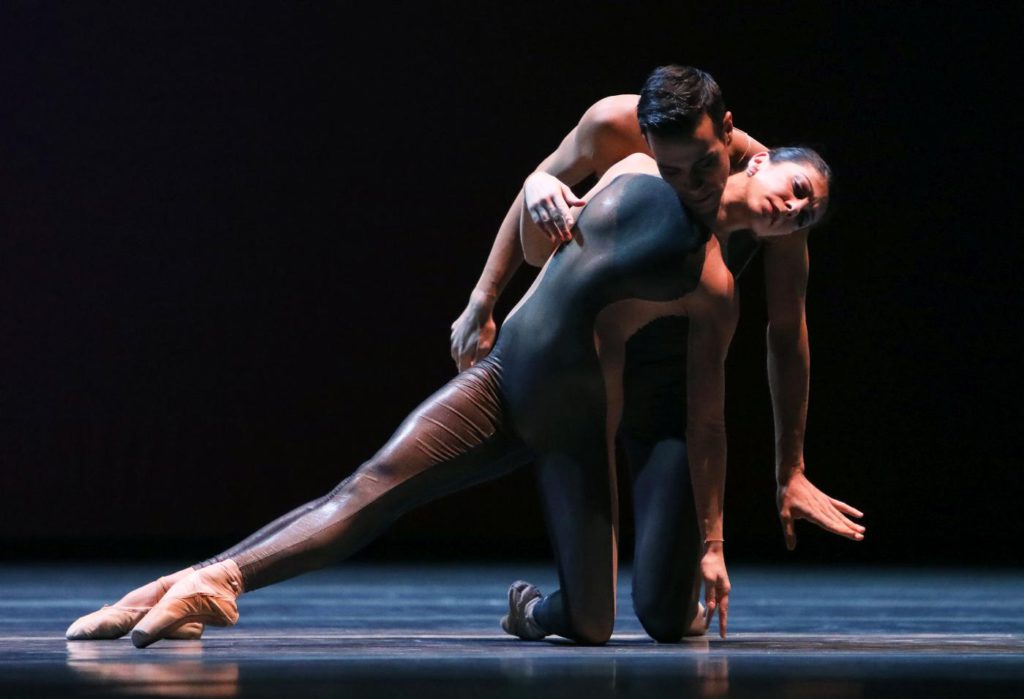 a supple, smiling teaser, the one flirting with the flute? In any case he is pulling the strings onstage and in Arqués’s intention symbolizes the rolling dice of the game. Upon Choi’s decision, upon his gesture, the other dancers start to move, individually or together, in sync or varied so that the movement of one triggered another like falling dominos. In a surprise moment five swings on long ropes swung in from the right wing. They flew in new dancers onto stage as if new playing cards or playing pieces were being brought into the game. Later, having been pushed vigorously, the dancers swung off stage again. Quite an inventive way to quickly clear the stage!
a supple, smiling teaser, the one flirting with the flute? In any case he is pulling the strings onstage and in Arqués’s intention symbolizes the rolling dice of the game. Upon Choi’s decision, upon his gesture, the other dancers start to move, individually or together, in sync or varied so that the movement of one triggered another like falling dominos. In a surprise moment five swings on long ropes swung in from the right wing. They flew in new dancers onto stage as if new playing cards or playing pieces were being brought into the game. Later, having been pushed vigorously, the dancers swung off stage again. Quite an inventive way to quickly clear the stage!
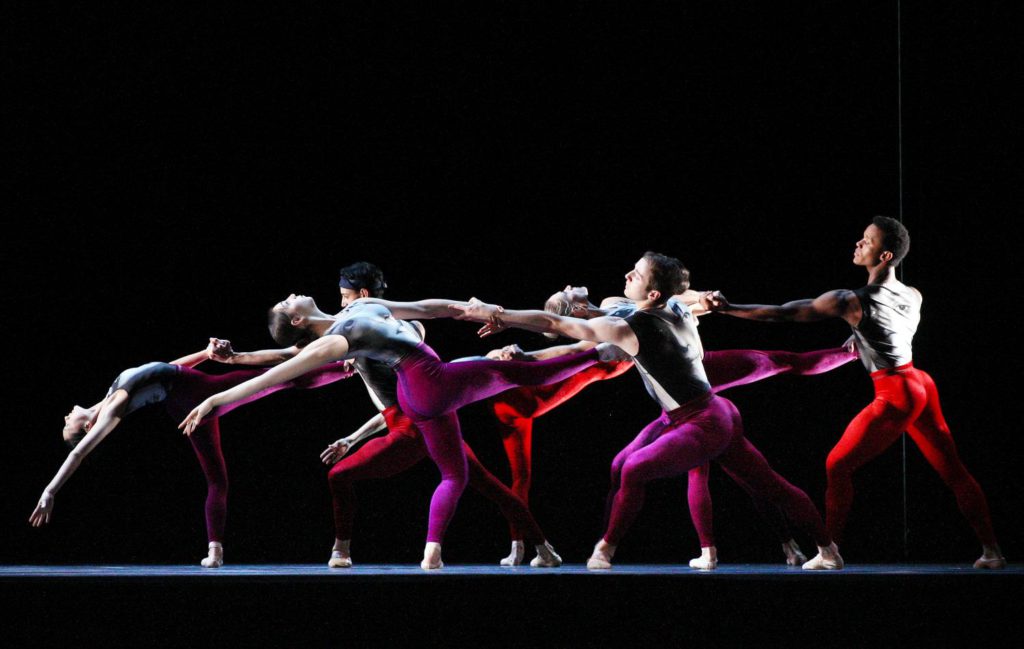 Choi often watched the game from the sidelines or sometimes from one swing he perched on. But he also had jittery moments, moments of confusion. Games can get out of control and that was the case when the music turned febrile. Suddenly the female dancers were held high by the men, their limbs stiffly protruding like animals caught in a wide-meshed fishnet. At the end neither the projection of an attractive woman on the wall nor the invitingly dangling swings tempted Choi. Resolutely he turned back to the flautist.
Choi often watched the game from the sidelines or sometimes from one swing he perched on. But he also had jittery moments, moments of confusion. Games can get out of control and that was the case when the music turned febrile. Suddenly the female dancers were held high by the men, their limbs stiffly protruding like animals caught in a wide-meshed fishnet. At the end neither the projection of an attractive woman on the wall nor the invitingly dangling swings tempted Choi. Resolutely he turned back to the flautist.
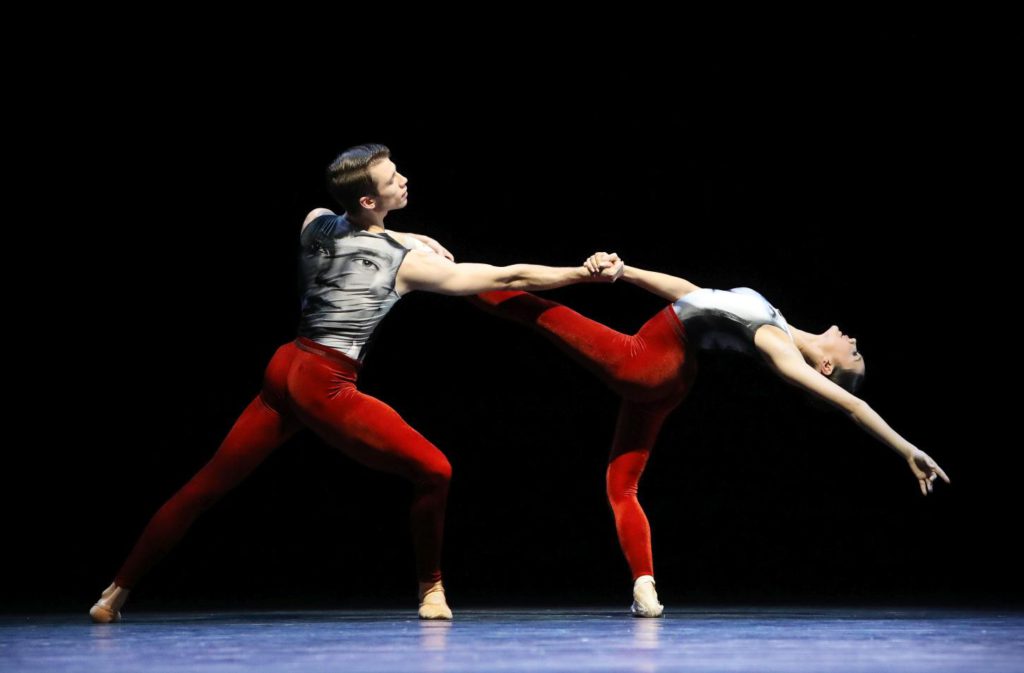 Arqués himself had created the set, a simple rectangular dark room, which Bert Dalhuysen’s lighting turned into a fictive space dominated by deep shadows on the right and prismatic colors blending into each other on the left. Costumes by Oliver Haller were of brown, skin-tight latex with a broad vertical transparent stripe on either side of the body.
Arqués himself had created the set, a simple rectangular dark room, which Bert Dalhuysen’s lighting turned into a fictive space dominated by deep shadows on the right and prismatic colors blending into each other on the left. Costumes by Oliver Haller were of brown, skin-tight latex with a broad vertical transparent stripe on either side of the body.
“In Transit”, the second piece of the program, was also a world premiere. Its choreographer is Ernst Meisner, artistic coordinator of Dutch National Ballet’s Junior Company and now for a few years one of the company’s regular choreographers. “In Transit” is a company piece for twenty-eight dancers to music of the same title by Joey Roukens. This music, a hectic, sometimes cacophonous mix of wooden percussion instruments, drums, bells, tinny clatter and 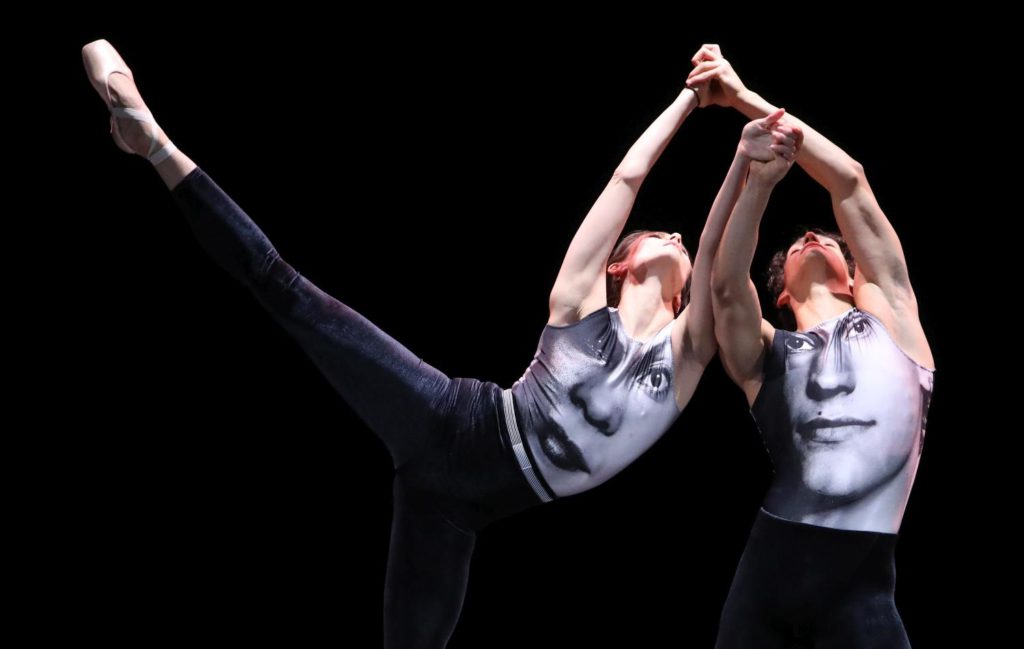
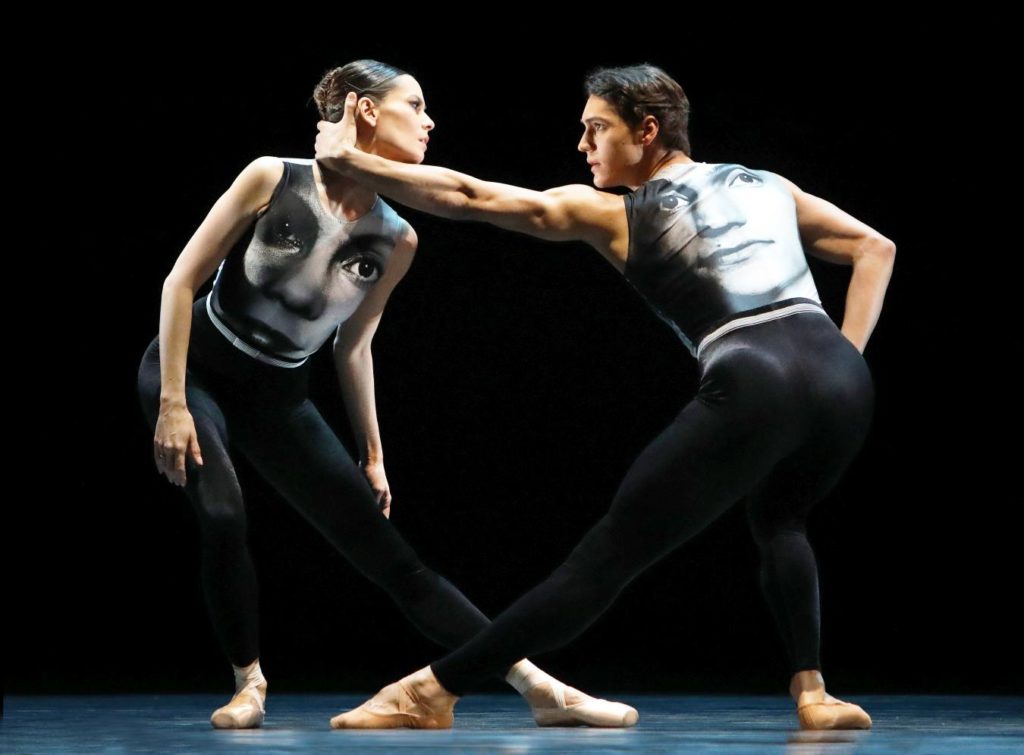 screeching strings mirrors for Meisner the time we live in, the daily rush. “We are running past each other but hardly see another”, he commented in the program booklet. Depicting this state became the core of “In Transit”.
screeching strings mirrors for Meisner the time we live in, the daily rush. “We are running past each other but hardly see another”, he commented in the program booklet. Depicting this state became the core of “In Transit”.
Meisner made the dancers walk from the left to the right side, run from the back to the front and vice versa. A group served as a decorative background for a couple’s pas de deux or piled into a bunch from a side wing as a heavy counterbalance to them. On one occasion, women were carried onstage horizontally like stiff boards, then laid on the floor. When a man was struck down, aggression and sudden violence were in the air. A small band of light on the backcloth, whose waves ran from the left side to the right side like an electric current pulse intensified the restless 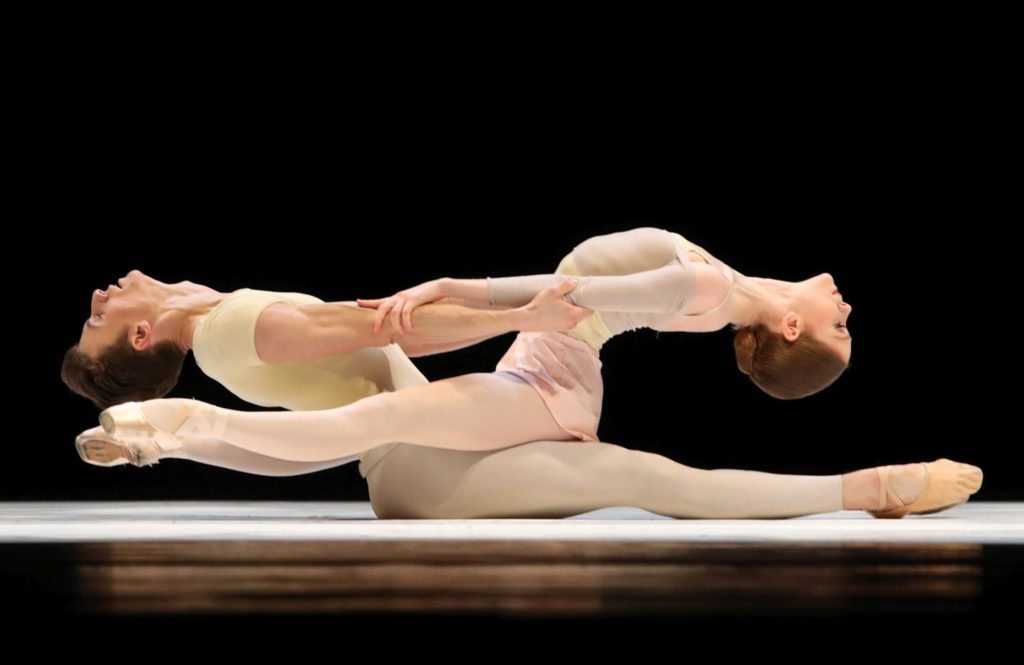 atmosphere. Yet, with the entrance of a new couple, Igone de Jongh and Daniel Camargo, harmony arose in the final minutes. The loving relationship they portrayed was an island of calm, a manifestation of meaning amidst aimless bustle.
atmosphere. Yet, with the entrance of a new couple, Igone de Jongh and Daniel Camargo, harmony arose in the final minutes. The loving relationship they portrayed was an island of calm, a manifestation of meaning amidst aimless bustle.
Keso Dekker’s costumes drew attention to another facet of social behavior, the discrepancy between striving for individuality and the need to belong to the group. Dekker put the dancers in velvety bright red or pink pants (only De Jongh and Camargo had black ones) and white tops on which black and white portraits of the dancers themselves were printed. An attempt to show one’s face? At least on the surface? The flurry of red and pink, which strongly contrasted with the black backcloth, sometimes caught the eye more than the dance itself. Who filled out the pants became irrelevant.
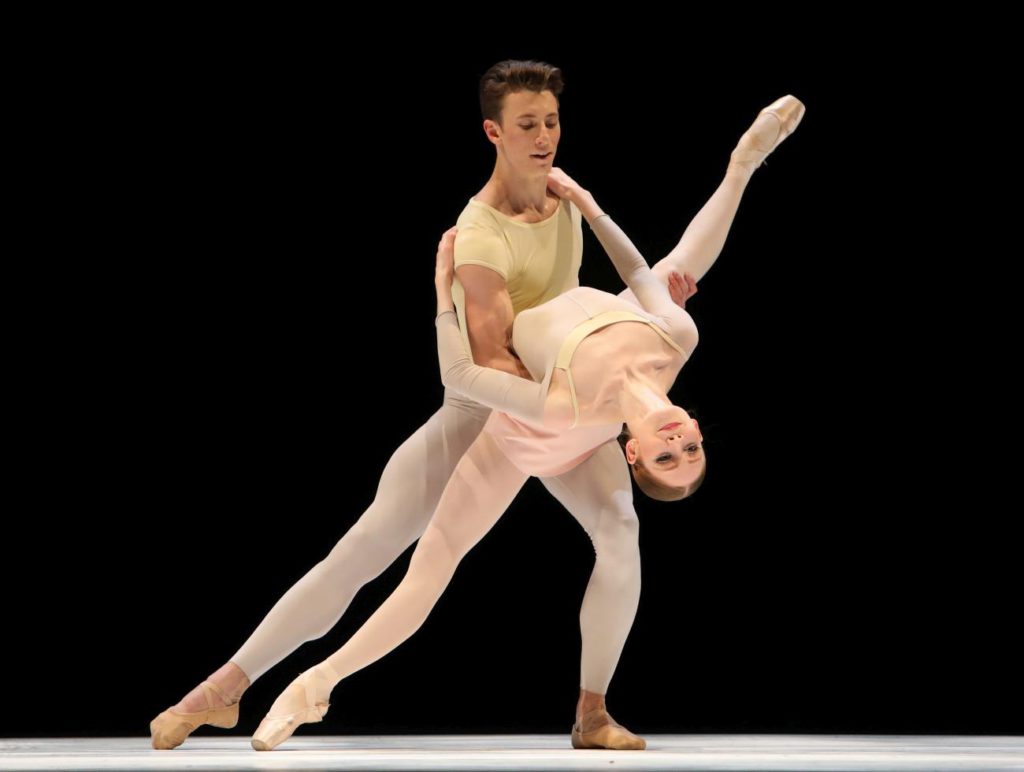
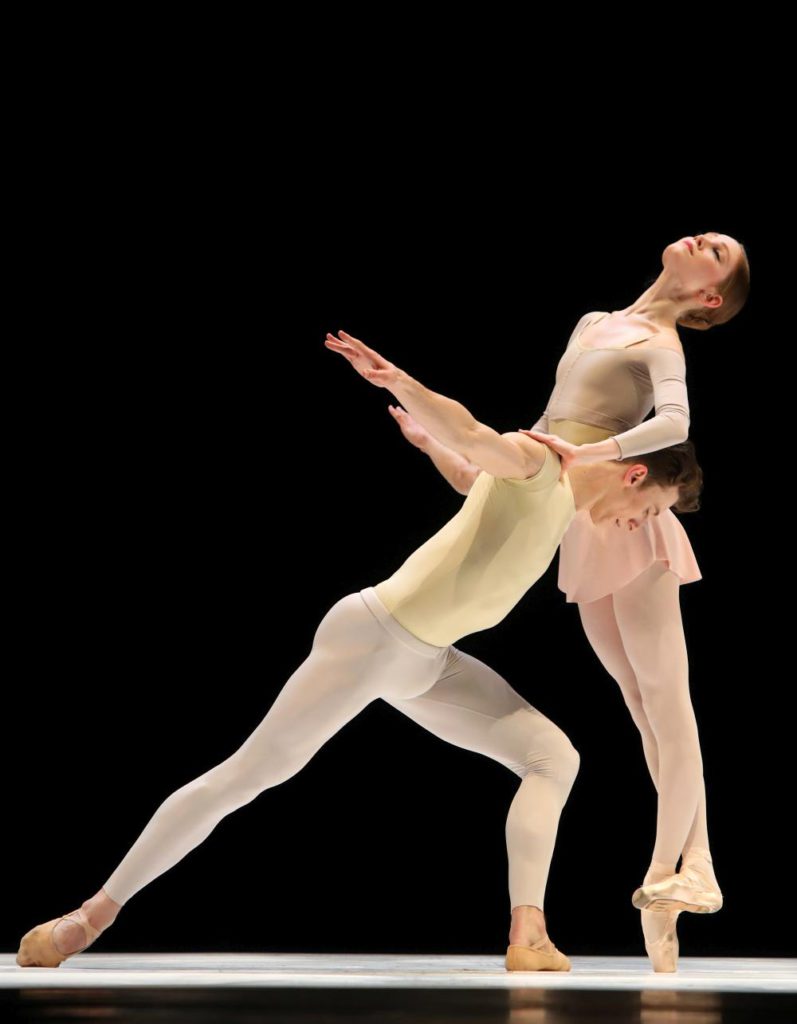 “Romance” by Ton Simons opened with a video, with close-ups of a young female and male dancer waiting for the curtain to go up. The young man, Matthew Pawlicki-Sinclair, checked his hairdo, the young lady, Erica Horwood, went over the choreography in her mind, marking some steps. Single piano tones dropped into the silence like the ticking of a clock. One felt their nervousness increase second by second, tone by tone. Finally the curtain rose. The couple stood apart, motionless, facing each other. At first sight I doubted whether they were really the same dancers as on the video. Her hair was less red, his facial features not exactly the same, but, upon second thought, I remembered that the piece had premiered in 2014. Certainly the video hasn’t been filmed again for the revival. But the people have changed.
“Romance” by Ton Simons opened with a video, with close-ups of a young female and male dancer waiting for the curtain to go up. The young man, Matthew Pawlicki-Sinclair, checked his hairdo, the young lady, Erica Horwood, went over the choreography in her mind, marking some steps. Single piano tones dropped into the silence like the ticking of a clock. One felt their nervousness increase second by second, tone by tone. Finally the curtain rose. The couple stood apart, motionless, facing each other. At first sight I doubted whether they were really the same dancers as on the video. Her hair was less red, his facial features not exactly the same, but, upon second thought, I remembered that the piece had premiered in 2014. Certainly the video hasn’t been filmed again for the revival. But the people have changed.
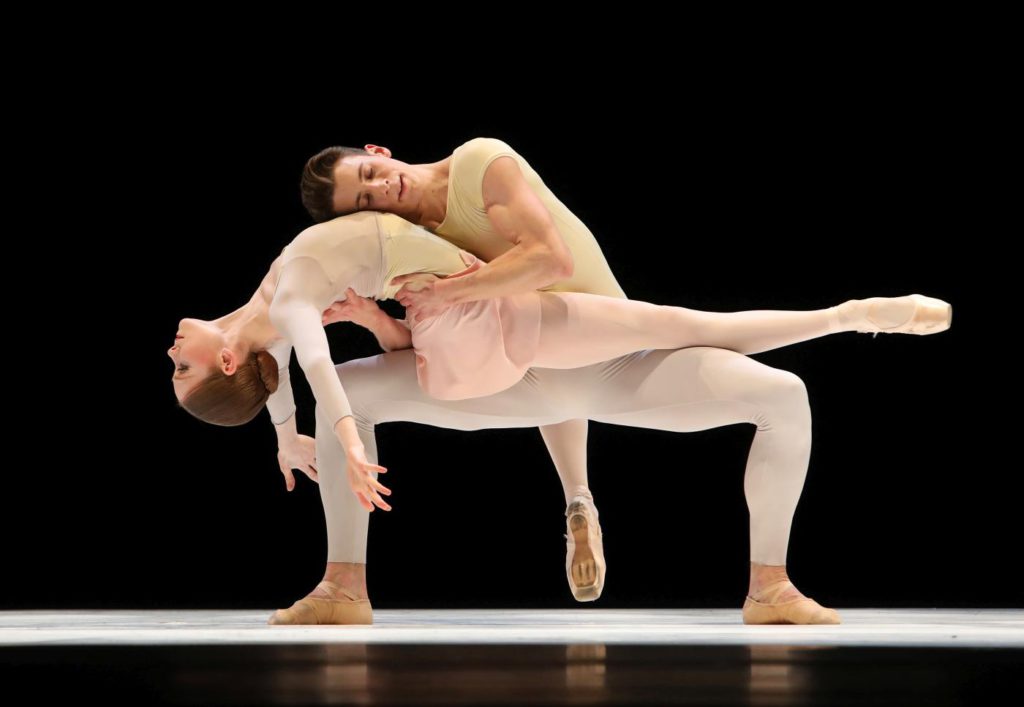 Simons set “Romance” to the middle section of Mozart’s piano concert in d-minor, also titled “Romance”. It is slow, serene and harmonious music, which includes a passage of slight turmoil. Simon responded to it with sedately paced movements, held poses and phrases danced in mirror image. At one point the dancers slowly move, one standing behind the other, their silhouettes overlapping like paper cutouts. Symmetry in general and planes of symmetry are as important to the work as is the tension created by the space between the dancers.
Simons set “Romance” to the middle section of Mozart’s piano concert in d-minor, also titled “Romance”. It is slow, serene and harmonious music, which includes a passage of slight turmoil. Simon responded to it with sedately paced movements, held poses and phrases danced in mirror image. At one point the dancers slowly move, one standing behind the other, their silhouettes overlapping like paper cutouts. Symmetry in general and planes of symmetry are as important to the work as is the tension created by the space between the dancers.
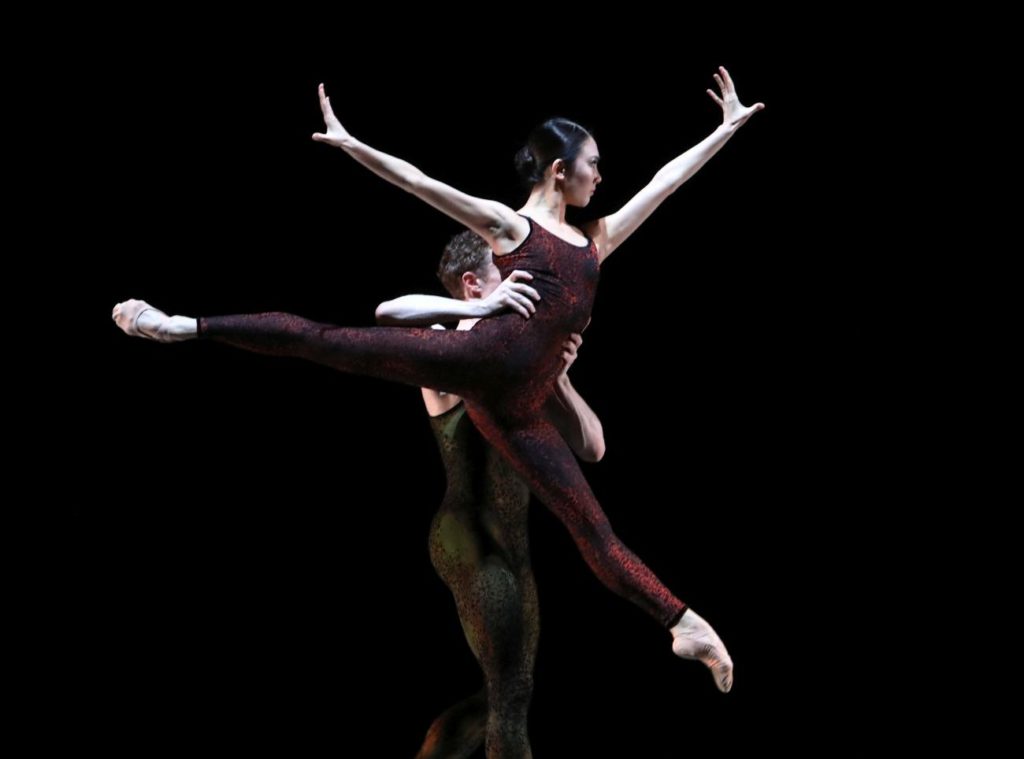 The costumes, practice clothes in delicate colors, provided the sweet touch of innocence and romance that the structured choreography withheld. I thought of the couple as resembling the two little figures on top of a three-tiered wedding-cake. The intimacy was in the video rather than in the pas de deux. A video also wrapped up the ballet. The curtain had just gone down in reality but on video we watched the dancers behind it. Looking at their faces I was uncertain how the dancers felt. They seemed still in another world.
The costumes, practice clothes in delicate colors, provided the sweet touch of innocence and romance that the structured choreography withheld. I thought of the couple as resembling the two little figures on top of a three-tiered wedding-cake. The intimacy was in the video rather than in the pas de deux. A video also wrapped up the ballet. The curtain had just gone down in reality but on video we watched the dancers behind it. Looking at their faces I was uncertain how the dancers felt. They seemed still in another world.
“Frank Bridge Variations”, an iconic piece by Dutch veteran master Hans van Manen, closed the evening. As the leading couples Qian Liu / Remi Wörtmeyer and Igone de Jongh / Daniel Camargo danced superbly. Wörtmeyer was a pliant nonchalant boaster in his solo, his smile irresistible. Camargo, bursting with vigor, danced like a bomb ready to explode. He 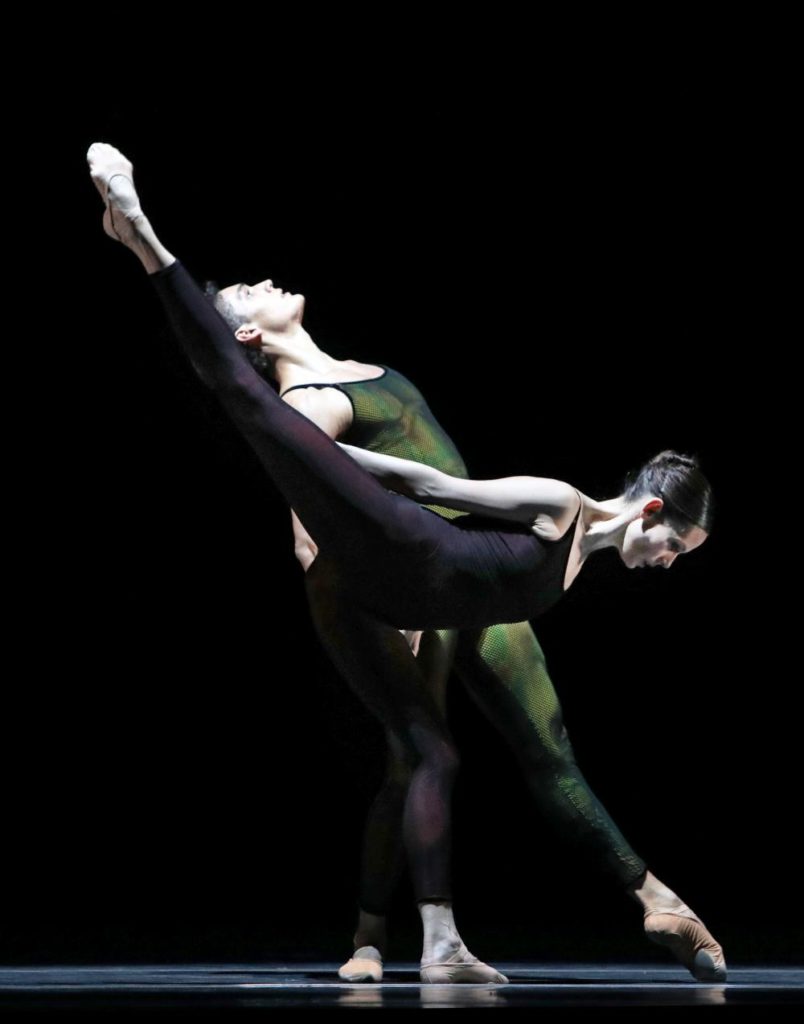
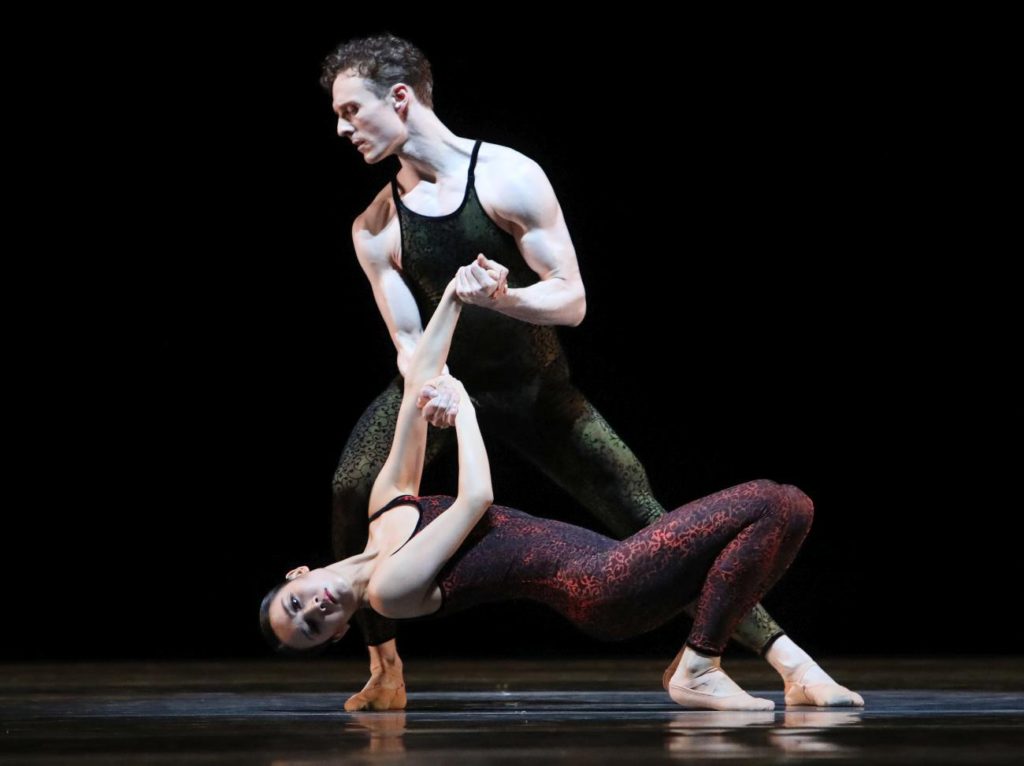 boiled with fury but still controlled his temper. The sudden changes between precise dance steps and casual walking, between sudden sharp moves and flowing phrases, the unexpected turns in behavior (as in real life, especially effective when leaving the stage), the switches from group scenes to pas de deux or solos… each of these were carved out trenchantly and were no less than thrilling. Hans van Manen’s style fits the company like a glove one of the troupe’s repetiteurs later said. She is right. The dancers looked terrific.
boiled with fury but still controlled his temper. The sudden changes between precise dance steps and casual walking, between sudden sharp moves and flowing phrases, the unexpected turns in behavior (as in real life, especially effective when leaving the stage), the switches from group scenes to pas de deux or solos… each of these were carved out trenchantly and were no less than thrilling. Hans van Manen’s style fits the company like a glove one of the troupe’s repetiteurs later said. She is right. The dancers looked terrific.
Different musical styles had to be mastered this evening through which Matthew Rowe guided the Het Balletorkest with assurance.
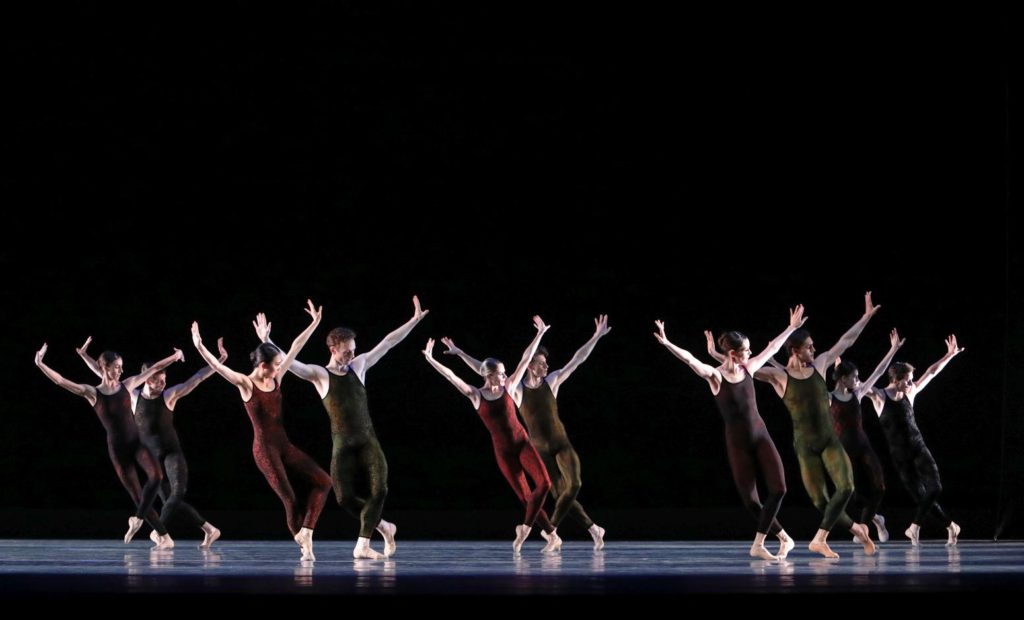
| Links: | Website of Dutch National Ballet | |
| Photos: | “Homo Ludens” (Juanjo Arqués) | |
| 1. | Michaela DePrince and James Stout, “Homo Ludens” by Juanjo Arqués, Dutch National Ballet | |
| 2. | Floor Eimers, Michaela DePrince, Nadia Yanowsky and Aya Okumura, “Homo Ludens” by Juanjo Arqués, Dutch National Ballet | |
| 3. | Suzanna Kaic and Vito Mazzeo, “Homo Ludens” by Juanjo Arqués, Dutch National Ballet | |
| 4. | Suzanna Kaic and Vito Mazzeo, “Homo Ludens” by Juanjo Arqués, Dutch National Ballet | |
| “In Transit” (Ernst Meisner) | ||
| 5. | Ensemble, “In Transit” by Ernst Meisner, Dutch National Ballet | |
| 6. | Sem Sjouke and Nancy Burer, “In Transit” by Ernst Meisner, Dutch National Ballet | |
| 7. | Igone de Jongh and Daniel Camargo, “In Transit” by Ernst Meisner, Dutch National Ballet | |
| 8. | Igone de Jongh and Daniel Camargo, “In Transit” by Ernst Meisner, Dutch National Ballet | |
| “Romance” (Ton Simons) | ||
| 9. | Matthew Pawlicki-Sinclair and Erica Horwood, “Romance” by Ton Simons, Dutch National Ballet | |
| 10. | Matthew Pawlicki-Sinclair and Erica Horwood, “Romance” by Ton Simons, Dutch National Ballet | |
| 11. | Matthew Pawlicki-Sinclair and Erica Horwood, “Romance” by Ton Simons, Dutch National Ballet | |
| 12. | Erica Horwood and Matthew Pawlicki-Sinclair, “Romance” by Ton Simons, Dutch National Ballet | |
| “Frank Bridge Variations” (Hans van Manen) | ||
| 13. | Remi Wörtmeyer and Qian Liu, “Frank Bridge Variations” by Hans van Manen, Dutch National Ballet | |
| 14. | Igone de Jongh and Daniel Camargo, “Frank Bridge Variations” by Hans van Manen, Dutch National Ballet | |
| 15. | Qian Liu and Remi Wörtmeyer, “Frank Bridge Variations” by Hans van Manen, Dutch National Ballet | |
| 16. | Ensemble, “Frank Bridge Variations” by Hans van Manen, Dutch National Ballet | |
| all photos © Hans Gerritsen 2017 | ||
| Editing: | Laurence Smelser |
